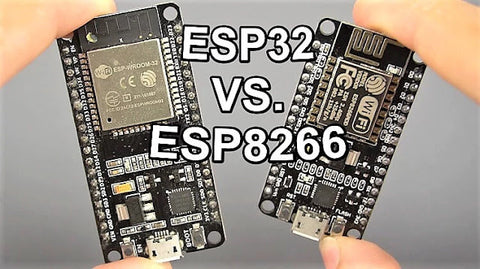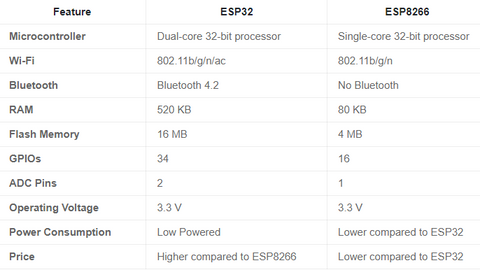ESP32 and ESP8266 are two microcontroller boards developed by Espressif Systems that are popularly used for building Internet of Things (IoT) projects. These boards are compact, low-power, and have built-in Wi-Fi connectivity, making them an ideal choice for many applications.

ESP32 vs. ESP8266
The ESP32 is a dual-core microcontroller with integrated Wi-Fi and Bluetooth. It has powerful processing power, memory, and peripherals compared to the ESP8266, making it suitable for complex IoT projects requiring more computational power. The ESP32 supports the 802.11b/g/n/ac Wi-Fi standard and has Bluetooth 4.2 capability, making it an ideal choice for applications requiring Wi-Fi and Bluetooth connectivity. The board also has 34 GPIOs and 2 ADC pins, providing ample connectivity options for various sensors and other peripherals.
On the other hand, the ESP8266 is a low-cost Wi-Fi microcontroller often used for IoT projects and home automation. Despite its limited processing power and memory compared to the ESP32, the ESP8266 is easier to use and has a large community of users and resources available. The board supports the 802.11b/g/n Wi-Fi standard but lacks the Bluetooth capability of the ESP32. It has 16 GPIOs and 1 ADC pin, sufficient for simple IoT projects.
Power consumption is an important aspect to consider when choosing between the ESP32 and ESP8266. The ESP8266 has lower power consumption than the ESP32, making it more suitable for battery-powered projects. However, the ESP32 has a lower power consumption than traditional microcontroller boards, and its dual-core design enables power-saving features unavailable on the ESP8266.
In terms of price, the ESP8266 is generally lower than the ESP32. However, the ESP32 is still an affordable option for building IoT projects, and its additional features and capabilities make it a better choice for more complex applications.
Technical differences between the ESP32 and ESP8266:

Choosing the right board for an IoT project can be challenging, as several factors need to be considered. However, by understanding your project's requirements and the capabilities of different boards, you can make an informed decision that will ensure the success of your project.
A step-by-step approach to select the perfect board for an IoT project:
- Determine your project's requirements: Before searching for a board, you must clearly understand your IoT project's requirements. Consider factors such as the number of sensors and other peripherals you need to connect, the type of connectivity you need (Wi-Fi, Bluetooth, etc.), and the amount of computational power required.
- Consider the size and power consumption: If your project is battery-powered, it's essential to choose a board that has low power consumption. The board size is also important, as it affects the overall size of your IoT device.
- Evaluate the connectivity options: Wi-Fi and Bluetooth are IoT projects' most common connectivity options. Consider the type of Wi-Fi standard you need (802.11b/g/n or 802.11b/g/n/ac) and whether you need Bluetooth connectivity.
- Look at the number of GPIOs and ADC pins: The number of GPIOs and ADC pins determines the number of sensors and other peripherals you can connect to the board. Consider the number of sensors you need to connect and choose a board with enough GPIOs and ADC pins to support your project.
- Consider the price: IoT boards vary in price, and choosing a board that fits your budget is essential. Remember that more advanced boards with more features tend to be more expensive.
Suppose you're building a smart home system that controls the lighting and temperature in your home using a mobile app. In this case, you need a board with Wi-Fi connectivity, enough GPIOs to connect to a few sensors and actuators, and low power consumption, as the system will run 24/7.
The ESP32 would be a suitable choice for this project based on these requirements. It has dual-core processing power, integrated Wi-Fi and Bluetooth connectivity, and enough GPIOs to support the sensors and actuators required. Its low power consumption and compact size make it a good fit for this application.
